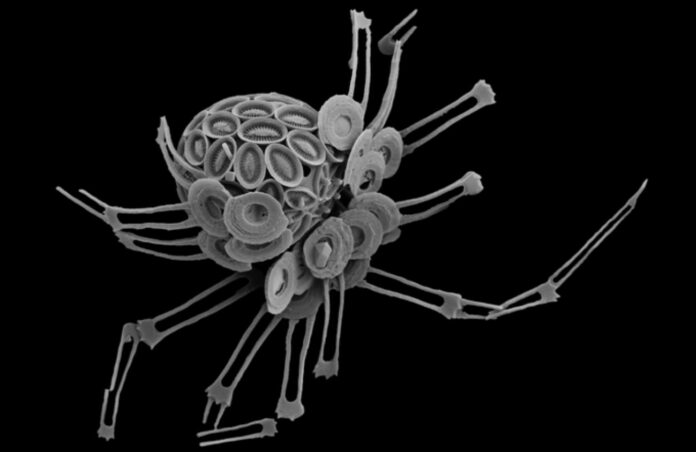Coccolithophores, a widely distributed type of phytoplankton, have a crucial role in the exchange of carbon between the ocean and atmosphere. Recent research conducted by the Bigelow Laboratory for Ocean Sciences reveals that these essential microorganisms are capable of surviving in low-light conditions by utilizing dissolved organic forms of carbon.
This discovery challenges existing notions regarding the mechanisms that drive carbon cycling in the ocean. The findings of this study have been published in Science Advances.
The process through which coccolithophores extract carbon directly from absorbed dissolved organic carbon is referred to as osmotrophy. While scientists had previously observed osmotrophy in lab-grown cultures of coccolithophores, this is the first evidence of this phenomenon occurring naturally.
Led by Senior Research Scientist William Balch, the research team conducted their experiments on populations of coccolithophores in the northwest Atlantic Ocean. They measured the rate at which phytoplankton consumed three distinct organic compounds, each labeled with chemical markers for tracking purposes.
The coccolithophores used the dissolved compounds as a carbon source for both the organic tissues that make up their single cells and the inorganic mineral plates they secrete around themselves, called coccoliths. Although the uptake of organic compounds was relatively slower compared to the rapid carbon absorption through photosynthesis by phytoplankton, it remained significant and should not be disregarded.
“The coccolithophores aren’t winning any ‘growth race’ by taking-up these dissolved organic materials,” Balch points out. “They are just eking out an existence, but they can still grow, albeit slowly.”
Plants, such as coccolithophores, typically obtain carbon for their growth through photosynthesis by extracting inorganic carbon from the atmosphere, specifically carbon dioxide and bicarbonate. When coccolithophores perish, they descend, carrying this carbon down to the ocean floor. There, it can either be remineralized or buried, effectively sequestering it for millions of years. This crucial process is known as the biological carbon pump.
Simultaneously, coccolithophores engage in a parallel process called the alkalinity pump. They convert bicarbonate molecules present in surface water into calcium carbonate, which forms their protective coccoliths, essentially creating limestone structures. Again, upon their demise and sinking, all this dense inorganic carbon is weighted down to the seafloor. Some of it subsequently dissolves back into bicarbonate, effectively ‘pumping’ alkalinity from the surface to the depths.
However, recent evidence suggests that coccolithophores aren’t solely reliant on inorganic carbon sources near the surface. They are also utilizing dissolved organic carbon, which represents the largest pool of organic carbon in the ocean. Coccolithophores incorporate a portion of this free-floating organic carbon into their coccoliths, which subsequently sink into the deep ocean. This discovery indicates that the uptake of these organic compounds floating freely in the ocean is an additional step in both the biological and alkalinity pumps that facilitate the transport of carbon from the ocean surface to the depths below.
“There’s this big dissolved organic carbon source in the ocean that we always assumed wasn’t really related to the carbonate cycle in the sea,” Balch adds. “Now we’re saying that some fraction of the carbon that is going to depth is really coming from that enormous pool of dissolved organic carbon.”
This publication marks the end of a three-year project funded by the National Science Foundation, representing the third and final paper in the series.
The project draws its inspiration from the pioneering research conducted by William Blankley, a former graduate student at Scripps Institution of Oceanography, which is also the alma mater of the project lead, Balch. Despite Blankley’s untimely demise, his groundbreaking doctoral thesis from the 1960s, in which he successfully cultivated coccolithophores in the absence of light for a duration of 60 days using glycerol as a nutrient, serves as the foundation for this endeavor. The ability to replicate Blankley’s findings several decades later, utilizing modern technology, attests to the excellence of his early work.
The latest study, however, presented a significant challenge as it aimed to conduct research beyond the confines of a controlled laboratory setting. The research team faced the task of devising a methodology capable of quantifying the presence of these organic compounds in seawater, which existed at ambient concentrations several orders of magnitude lower than those observed in Blankley’s experiments. Furthermore, the team sought to monitor the uptake of these compounds by wild coccolithophores in their natural environment.
“When you culture phytoplankton in the lab, you can grow as much as you want. But in the ocean, you take what you get,” Balch remarks. “The challenge was finding a signal in all the noise to say, proof positive, that it was coccolithophores taking up these organic molecules into their coccoliths.”
Despite the completion of the current project, Balch stated that the subsequent investigation will focus on determining whether coccolithophores possess the ability to uptake additional organic compounds present in seawater at comparable rates to the three compounds already tested. While the coccolithophores exhibited slow utilization rates for the three dissolved compounds during these experiments, there exist numerous other organic molecules in seawater that they potentially have the capacity to absorb. If they indeed demonstrate a higher uptake of these compounds, this discovery could represent a more substantial advancement in comprehending the global carbon cycle.
Source: 10.1126/sciadv.adf6973
Image Credit: Colin Fischer, Bigelow Laboratory for Ocean Sciences
